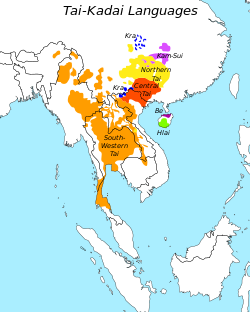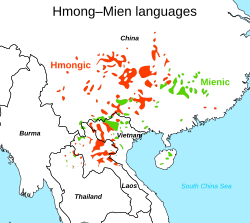žė§žä§Ū䳎¶≠žĖīž°Ī
žė§žä§Ū䳎¶≠žĖīž°Ī(žėĀžĖī: Austric languages)[1] ŽėźŽäĒ Žā®Žį©žĖīž°Ī(ŚćóśĖĻŤ™ěśóŹ)žĚÄ ŽŹôŽā®žēĄžčúžēĄžôÄ ŪÉúŪŹČžĖϞ󟞥ú ž£ľŽ°ú žďįžĚīŽäĒ žĖłžĖīŽď§žĚī žĚīŽ£¨Žč§Í≥† ŪēėŽäĒ ÍįÄžĄ§žÉĀžĚė žĖīž°ĪžĚīŽč§. žė§žä§Ū䳎¶≠žĖīž°ĪžóźŽäĒ ŪÉÄžĚīžôĄ, ŽßźŽ†ąžĚī ž†úŽŹĄ, ŪÉúŪŹČžĖĎ žĄ¨Žď§, ŽßąŽč§ÍįĞ䧞ĻīŽ•īžóź Ž∂ĄŪŹ¨ŪēėŽäĒ žė§žä§Ū䳎°úŽĄ§žčúžēĄžĖīž°ĪÍ≥ľ ŽĆÄŽ•ôŽ∂Ä ŽŹôŽā®žēĄžčúžēĄ, žĚłŽŹĄ, ŽĄ§ŪĆĒ, Žį©ÍłÄŽĚľŽćįžčúžĚė žė§žä§Ū䳎°úžēĄžčúžēĄžĖīž°ĪžĚī ŪŹ¨Ūē®ŽźúŽč§. žĚī žĖīž°ĪŽď§ ÍįĄžĚė Í≥ĄŪÜĶž†Ā ÍīÄŽ†®žĄĪžĚÄ Í∑łŽüī ŽďĮŪēī Ž≥īžĚīŽāė žēĄžßĀ ÍįÄžĄ§ Žč®Í≥Ąžóź Ž®łŽ¨īŽ•īÍ≥† žěąŽč§.[2] žĚīžóź ŽćĒŪēī žĚľŽ∂Ä žĖłžĖīŪēôžěźŽď§žĚÄ žĚľŽ≥łžĖīž°ĪÍĻĆžßÄ ŪŹ¨Ūē®žčúŪā§ÍłįŽŹĄ ŪēúŽč§.[3][4][5] žė§žä§Ū䳎¶≠žĖīž°ĪÍ≥ľ ÍīÄŽ†® žěąŽäĒ ÍįÄžĄ§Ž°úŽäĒ Ž°úŽěĎ žā¨ÍįÄŽ•īžĚė ž§ĎÍĶ≠žė§žä§Ū䳎°úŽĄ§žčúžēĄžĖīž°ĪÍ≥ľ ŪŹī Ž≤†ŽĄ§ŽĒēŪäłžĚė žė§žä§Ū䳎°úŪÉÄžĚīžĖīž°ĪžĚī žěąŽč§.[6] žó≠žā¨žė§žä§Ū䳎°ú ŽĆÄžĖīž°ĪžĚÄ ŽŹÖžĚľ žĄ†ÍĶźžā¨ ŽĻĆŪ󨎶Ą žäąŽĮłŪäłÍįÄ 1906ŽÖĄžóź ž≤ėžĚĆ ž†úžēąŪēėžėÄŽč§. žäąŽĮłŪ䳎äĒ žĚĆžöīŽ°†, ŪėēŪÉúŽ°†, žĖīŪúėŽ°† Ž©īžĚė ž¶ĚÍĪįŽď§žĚĄ ŪÜĶŪēī žė§žä§Ū䳎°úžēĄžčúžēĄžĖīž°ĪÍ≥ľ žė§žä§Ū䳎°úŽĄ§žčúžēĄžĖīž°Ī(ž†ēŪôēŪ칎äĒ ŽßźŽ†ąžĚīŪŹīŽ¶¨ŽĄ§žčúžēĄžĖīŪĆĆ)žĚī žė§žä§Ū䳎¶≠žĖīž°ĪžĚĄ žĚīŽ£¨Žč§Í≥† ž£ľžě•ŪĖąŽč§. 1942ŽÖĄ ŪŹī Ž≤†ŽĄ§ŽĒēŪ䳎äĒ žė§žä§Ū䳎¶≠žĖīž°ĪžĚĄ žě†ž†ēž†ĀžúľŽ°ú žąėžö©ŪēėÍ≥† Ūôēžě•Ūēī, ŪĀ¨ŽĚľŽč§žĚīžĖīž°ĪžĚĄ žė§žä§Ū䳎°úŽĄ§žčúžēĄžĖīž°ĪžĚė žßĀÍ≥Ą ŪēėžúĄ Ž∂ĄŽ•ėÍĶįžúľŽ°ú ŪŹ¨Ūē®žčúžľįžúľŽ©į, Ž™ĹŽ™źžĖīž°ĪŽŹĄ ŪŹ¨Ūē®Žź† ÍįÄŽä•žĄĪÍĻĆžßÄ Í≥†Ž†§ŪĖąŽč§[7] Í∑łŽü¨Žāė Ž≤†ŽĄ§ŽĒēŪ䳎äĒ žĚīŪõĄ žė§žä§Ū䳎°úŪÉÄžĚī ÍįÄžĄ§žĚĄ Ūôēžě•ŪēėŽ©īžĄú žė§žä§Ū䳎¶≠žĖīž°ĪžĄ§žĚÄ ŪŹźÍłįŪēėÍ≥† Í≥ĶÍįúž†ĀžúľŽ°ú ÍłįÍįĀŪĖąŽč§.[8] žĖīŪúė Ž©īžĚė ž¶ĚÍĪįŽäĒ ŽĻąžēĹŪēėŽāė, ž£ľŽ°ú ŪėēŪÉúŽ°†žĚĄ Í∑ľÍĪįŽ°ú žė§žä§Ū䳎°úŽĄ§žčúžēĄžĖīž°ĪÍ≥ľ žė§žä§Ū䳎°úžēĄžčúžēĄžĖīž°Ī ÍįĄžĚė žóįÍīÄžĄĪžĚĄ ž£ľžě•ŪēėŽäĒ žĚīŽď§žĚÄ žė§ŽäėŽā†žóźŽŹĄ ž°īžě¨ŪēúŽč§. žĚľŽ∂ÄŽäĒ ŽčąžĹĒŽįĒŽ•īžĖīŪĆĆžôÄ žė§žä§Ū䳎°úŽĄ§žčúžēĄžĖīž°Ī ÍįĄžóź žĶúÍ∑ľ ŽįĚŪėĞߥ ŪėēŪÉúŽ°†ž†Ā žú†žā¨žĄĪžĚī Í≥ĄŪÜĶ ÍīÄÍ≥ĄŽ•ľ Ūôēžč§Ūěą ž¶ĚŽ™ÖŪēúŽč§Í≥† ŽĮŅŽäĒŽč§. Žč§Ž•ł žóįÍĶ¨žěźŽď§žĚÄ Í≥ĄžÜćŪēīžĄú žė§žä§Ū䳎°úŽĄ§žčúžēĄžĖīž°ĪÍ≥ľ žė§žä§Ū䳎°úžēĄžčúžēĄžĖīž°Ī ŽėźŽäĒ ŪĀ¨ŽĚľŽč§žĚīžĖīž°Ī ÍįĄžĚė žěÉžĖīŽ≤ĄŽ¶į žĖīŪúėž†Ā Í≥†Ž¶¨Ž•ľ žįĺÍ≥† žěąŽč§. Reid (2005)žóźžĄúŽäĒ žė§žä§Ū䳎¶≠žĖīž°Ī ÍįÄžĄ§žĚė ŪėĄŪô©žĚĄ žöĒžēĹŪĖąŽč§. žěźŽŹôŪôĒ žú†žā¨ŽŹĄ ŪĆźž†ē ŪĒĄŽ°úÍ∑łŽě®(ASJP)Ž•ľ Ūôúžö©Ūēú 2015ŽÖĄžĚė Ž∂ĄžĄĚžĚÄ žė§žä§Ū䳎¶≠žĖīž°Ī ÍįÄžĄ§žĚĄ žßÄžßÄŪēėžßÄ žēäŽäĒŽč§. žĚī Ž∂ĄžĄĚžóźžĄúŽäĒ žė§žä§Ū䳎¶≠žĖīž°Ī ÍįÄžĄ§žĚė "ŪēĶžč¨" ÍĶ¨žĄĪžõź ŪõĄŽ≥īŽď§žĚĄ žė§žä§Ū䳎°úŪÉÄžĚīžĖīž°ĪÍ≥ľ žė§žä§Ū䳎°úžēĄžčúžēĄžĚľŽ≥łžĖīž°ĪžĚīŽĚľŽäĒ, žĄúŽ°ú Žč§Ž•īÍ≥† ÍīÄŽ†® žóÜŽäĒ ŽĎź ÍįúžĚė Ž∂ĄÍłįÍĶįžóź Žįįž†ēŪĖąŽč§.[9] Í∑łŽü¨Žāė ASJPŽäĒ žĖīž°Ī ÍįĄžĚė ÍīÄÍ≥ĄŽ•ľ ŪôēŽ¶ĹŪēėÍĪįŽāė ŪŹČÍįÄŪēėŽäĒ Žćį ž†Āž†ąŪēú Žį©Ž≤ēžúľŽ°úžĄú žó≠žā¨žĖłžĖīŪēôžěźŽď§ žā¨žĚīžóźžĄú ŽĄźŽ¶¨ žĚłž†ēŽįõžßÄŽäĒ Ž™ĽŪēėÍ≥† žěąŽč§ŽäĒ ž†źžĚĄ žēĆžēĄŽĎė ŪēĄžöĒÍįÄ žěąŽč§.[10] Ž∂ĄŽ•ė ž≤īÍ≥ĄžēĄŽěėžĚė Ž∂ĄŽ•ė ž≤īÍ≥Ą[ž∂úž≤ė ŪēĄžöĒ]ÍįÄ ÍįÄžě• Ž≥īŪéłž†ĀžĚł Žį©žčĚžĚīŽč§. Ž™ĹŽ™źžĖīž°ĪžĚÄ ÍįÄŽĀĒ ŪŹ¨Ūē®ŽźėÍłįŽŹĄ ŪēėŽāė, žĘÖžĘÖ žė§žä§Ū䳎°ú ŽĆÄžĖīž°ĪžóźžĄú ž†úžôłŽźúŽč§.
Í∑łŽü¨Žāė žĄłŽ•īÍ≤ĆžĚī žä§ŪÉÄŽ°úžä§ŪčīžĚÄ žė§žä§Ū䳎¶≠žĖīž°ĪžĚĄ ŽĎź ž£ľžöĒ Ž∂ĄÍłįÍĶįžúľŽ°ú ŽāėŽąąŽč§. žė§žä§Ū䳎¶≠žĖīž°ĪžĚÄ Í∑łÍįÄ ž†úžēąŪēú ŽćįŽĄ§žļÖžĻīžä§žĖīž°ĪÍ≥ľ ÍįÄžě• ÍįÄÍĻĆžöįŽ©į, ŽćįŽĄ§Žč§žĚī ŽĆÄžĖīž°ĪžĚĄ žĚīŽ£¨Žč§Í≥† Ž≥łŽč§.[11]
2015ŽÖĄžóź žēĆŽ†ČžāįŽćĒ Ž≥īŽĻąžĚī žĚľŽ≥łž°įžĖī žóįÍĶ¨Ž•ľ ŽßąžĻú Ží§ÔľĆžĚľŽ≥łžĖīž°ĪÍ≥ľ žė§žä§Ū䳎¶≠žĖīž°ĪžĚė žĖłžĖīžĚė ŽįÄž†ĎŪēú ÍīÄÍ≥ĄŽ•ľ ÍĪįŽ°†ŪēėŽ©īžĄúԾƞĚīžóź ÍīÄŪēú žĄ§žĚĄ ž†úžčúŪĖąžßÄŽßĆ Í∑łÍ≤Ć 1991ŽÖĄžóź ŪŹī Ž≤†ŽĄ§ŽĒēŪäłÍįÄ ž†úžčúŪĖąŽćė ŪēôžĄ§žĚīžóąŽč§.[12]
Í∑łŽ†áÍ≤Ć žēĆŽ†ČžāįŽćĒ Ž≥īŽĻąžĚī ž†úžčúŪēú žĄ§žĚī 1991ŽÖĄžúľŽ°ú ž†úÍłįŽźėžóąÍłį ŽēĆŽ¨łžóź žė§žä§Ū䳎¶≠žĖīž°ĪžĚĄ ž§ĎÍĶ≠ŪčįŽ≤†ŪäłžĖīž°ĪžĚė žĄ†ž°įŽ°ú Žč§žčú ž∂Ēž†ēŪēėžó¨ ÍĪįŽ°†ŽźėžóąŽäĒŽćį žėąŽ•ľ Žď§žĖī žä§ŪɆŽ¶¨ žä§ŪÉÄŽ°úžä§ŪÉÄ(2005)ÍįÄ žĚīŽ†áÍ≤Ć Žč§žčú ž†úžčúŪĖąŽč§.
Ž∂ĄŪŹ¨
ÍįôžĚī Ž≥īÍłįÍįĀž£ľ
|
|||||||||||||||||||||||||||||||||||||||||||||||||||||||||||||||||||||||||||||||||||||||||||||||||||||||||||||||||
Portal di Ensiklopedia Dunia

















